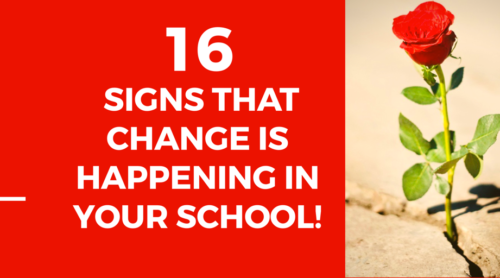16 Signs that Real Change is Happening in your School
When you are in the belly of the beast, it feels like you are getting slowly digested. But little do you know that the beast is changing. Culturally Responsive Leadership is about looking for the signs of change and continuing to push.
A version of this article appeared on the School Leaders Now Blog.
Inside the Belly of the Beast
One of my early mentors, and culturally responsive leaders, Trevor Gardner talks about “leading while in the belly of the best.” What does this mean? It’s important that we remember that this system of public education–especially in low-income areas predominantly serving students of color–is designed to promote the status quo, one of classism, racial hierarchy, and patriarchy. It is a well-fed monster and when we are working against it, it feels like we are Jonah in the whale.
When you are in the weeds of disengaging staff meetings, discriminatory discipline processes, and low expectation having classrooms, it’s hard to see that the forest is growing.
Personal Reflections
In my 7th year as a school administrator, 5th as principal at my current school, I sometimes feel like we are in the mud. Of course, I have the utmost respect for my teachers and staff, and I have seen tremendous growth. Our staff has chosen to dedicate their time, some their entire lives, to serving public school students. But I look at our achievement numbers, I focus on one interaction, or one class period and I feel like so much more needs to happen. I mean, how long do my students have to wait for the highest quality of teaching? How many graduating classes can we send to the next level, underprepared? Sometimes, I fixate too much on my vision that I forget where we started.
It’s hard to feel like change is happening, especially when you are working with an entrenched staff, in an under-resourced school, or in a repressive school district. I am glad that none of these are true for myself, but all leaders can’t say this. Or, you may have been at it for years like myself. When you first start at a new school it’s easy to feel alone. (here are a few tips for that). And after a few years, it’s easy to feel stagnant, like you change isn’t sticking, like the beast is devouring you.
But, how do you know if it is working? How do you know if you are making progress?What are the indicators of success? What signs do you have to keep you pushing?
16 Signs that Change is Happening

1) The Choir Starts to Preach
If you are lucky, leaders will find bright spots on their team and focus on them. During Staff Professional Development, it can feel like they are the only ones listening and in alignment with your vision. You know change is happening, when Teacher-Leaders take over planning, facilitating, and analyzing professional development. This looks like Professional Learning Communities, typical whole staff meetings, or small teams.

2) Your Micro-Politics affect the larger campaign
The term ‘micro-politics’ involves one on one conversations with folks to build trust, relationship, and listen, a hallmark of being a listening leader. This also includes floating an idea to staff who are on your team and those who criticize your vision. By talking with them you can get feedback before introducing a larger change. You know change is happening when those folks speak up and motivate the larger group to improve a school-wide focus like writing across the curriculum.

3) Your Teacher Union blends with your Leadership Teams
Many times teacher unions have a focus on protecting the rights of their union body, as they should. However, if your union team is always reactive to fires, they cannot be proactive and work towards transformation. You know change is happening when your union team starts to predict where there might be issues and starts using the pronoun “we” to describe administration and the teaching staff.

4) No one is allowed to fake it
Oftentimes when we hear about a new initiative like Restorative Justice circles, some staff fully use them, and other smile, nod, and go back to what they were doing before. Further, staff will ignore their colleagues’ poor practices and opt to avoid straining relationships. But, you know change is happening, when staff stop closing their doors and instead want to hold their colleagues accountable. You might hear a staff member say, “Let’s be honest about how much we are trying really all trying here. It’s time we step up and get on the same page.”

5) Veteran Staff Volunteer to Support New Staff
We know that your first few years working in a school, or teaching a new subject or grade level are challenging. This problem is compounded when you work in a Title 1 school with a large opportunity gap. When you veterans see the patterns of new teachers struggling and burning out, but instead offer to mentor and support new staff change is happening. Also, when you see experienced staff collaborating with new folks after school and helping in their classroom, your adult culture is changing.

6) Staff advocate to keep past initiatives alive
There is always a new thing to focus on and new leaders are good for wiping the slate clean and establishing new foci. When your staff says that we need to go deeper and actually get good at something like annotating text, it means that the expectation for quality teaching is rising. This is especially powerful when staff remember something you introduced previously that they don’t want to fall between the cracks.

7) You see Change in Unexpected Places
We often work with teachers, but you might be surprised by where that change shows up. You might see security guards requesting that there is a weekly meeting so that they are on the same page. Also, you might notice teaching aids using the language of Project-Based Learning that you introduced in a staff meeting. You might hear your secretaries talking about your school vision to prospective parents.

8) People Request Help for what was once seen as Forced
Early in your leadership, you might offer coaching support to design unit plans. Later you might see teachers asking for a day off to plan a PBL unit or asking for you to help design an agenda for looking at student work during a grade level meeting. This shows that people see your vision, support it, and also see the resources you are aligning to the vision.

9) The focus moves from Behavior to Instruction
In working with children, we often believe that we cannot teach if students are not well behaved. This leads many educators to making endless time to talk about classroom management, school policies, and consequences. Due to implicit bias, this is especially true when working with low income, students of color. When staff wants to talk about engaging students, providing support, and deeper learning, you know change is happening. This looks like redirecting a conversation from student behavior to student learning, or looking at student work as opposed to behavioral referrals.

10) New Leaders Step Up and Lead
You cannot do all this alone. You need new leaders and you are probably working to cultivate them. However, when leaders will step up, even folk who may have pulled back from taking on extra tasks in the past. Don’t be surprised if some of your first or second year teachers show the capacity and passion to lead their colleagues. This can also look like people wanting to form phonics committees, spearhead a trip to a Math conference, or plan staff social events.
11) People say “It Just Feels Different”
When you are looking for signs of change, you often look at the big data, test scores, graduation rates, and suspensions. However, when ask people if they can see changes, you might hear someone say, “It just feel different,” “It feels like students are actually learning,” or “It seems like staff want to be here.” These are the qualitative signs of change an anecdotal pieces of data that don’t always get recorded on your schools accountability report card.

12) There are fewer Staff Absences
When I first started, I was blown away by how many people were out each day. Don’t get me started on the Fridays or the day before long weekends. It was a mad scramble each morning and I was often subbing classes and stressing out. However, when you come in and check the sub board and it says “No Vacancies,” things are getting better. This means people want to be there, prioritize consistency for the students and don’t want to leave their team hanging.

13) Teachers Cover Each Other Classes
Building on the last point, when people are out, it is very difficult to find coverage. But when teachers come in, see that people are out and ask, “How can I help?” or say “I can take Ms. X’s 2nd period,” you know you are going in the right direction. When teachers talk to each other to get coverage, without even letting you know, the culture is getting stronger.

14) You, the Leader actually get some love and appreciation
I know, this is few and far between for a leader. Especially one pushing change and challenging the status quo. But, when you get acknowledgement for your hard work, dedication, and inclusive leadership, that means something. It means that folks see your work and value praising you more than preserving the division between teachers and leaders. This might happen during appreciations at a meeting, on social media, or go through the grapevine and get back to you. Cherish it.

15) Teams Form Organically
You have plenty of official groups such as leadership teams, grade level teams, and subject area departments. But when groups come together on their own, you know that the culture is shifting. These teams might not even have a name or be paid! They form to address a need or pursue a common passion. All you need to do is water the grass and let it grow. Find a way to highlight their work and share it with others.

16) Staff redirect each other in Meetings
Sometimes people cringe when their colleagues speak, but say nothing. They might look the other way or talk about staff after the meeting in the parking lot. But when a redirection happens during a meeting, you know that culture is changing. You might hear someone say, “I am not comfortable with how you are describing our students,” or “I want to hear from everyone in the meeting, what do you think Ms. X?” You might have to model this beforehand or do some micropoliticking, but when it happens it is powerful.
The work of reforming schools, within our ancient system can feel both overwhelming and draining. Waiting for transformation can feel like watching the grass grow. Leaders are tasked with getting results, which leads to a sense of urgency and the expectorations that change will be fast. Anyone who has tried it, has seen that change is not fast, but there are 16 signs to watch for.

The grass is not greener on the other side, it is greenest where YOU water it.
What you can do grow this change
- Build and coach the teams and team leaders
- Institutionalize the things you are holding or leading
- Write your thoughts on paper and call it a strategic plan
- Add resources to support that change (money and time)
- Magnify the bright spots
- Slow down and keep at it
- Create a norm that nurtures what you envision
- Celebrate the shit out of everything positive

Conclusions
As culturally responsive leaders, we fail to zoom out and see the progress we’ve made or remind us of where we started. This is the curse of consciousness. The urgency. Consequently, we walk around with a hammer, finding nothing but nails. Who am I, John Henry? Easy to do, and very unfulfilling. But what would happen if instead, we walked around with a flashlight looking for things to illuminate? Or what if we walked around with a wrench, only needing to slightly tighten a few bolts? This is is what it means to engineer for equity, to use culturally responsive leadership.



